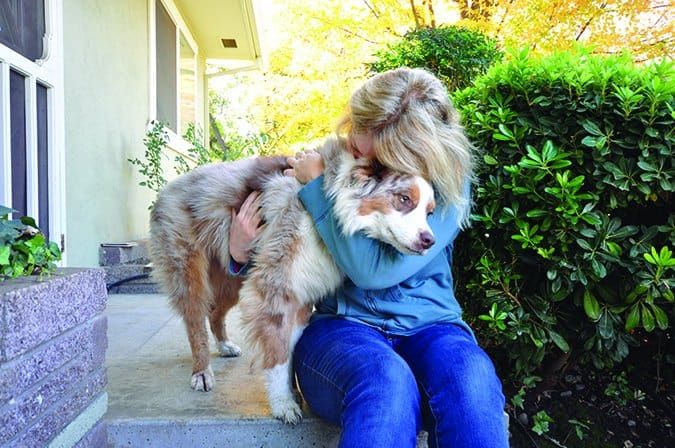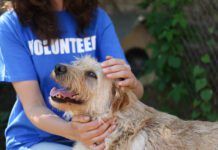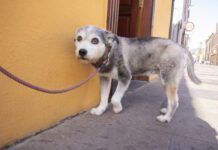[Updated January 16, 2018]
Perhaps the most common mistake that humans make when they want to make friends with a dog they don’t know is to bend over him, looking him in the eyes and patting him on the head. What they don’t realize is that everything about that interaction is – from the average dog’s perspective – rude, rude, rude. For a supposedly intelligent species, we humans tend to be incredibly dense about communicating with our canine companions.

People who work successfully with dogs either have good instincts about how to interact with them, or they learn quickly. There is a real art to using body language to help a dog feel at ease with your presence. The most competent professionals make training look almost effortless, because all the messages they convey to their canine pupils are calm, clear, and consistent – and that means both the cues and rewards they use consciously, and the posture and movements they use without thinking.
But if your body language is unintentionally intimidating, erratic, or contradicts the cues you are trying to give, the result can be a very confused, uncertain, frightened, or aggressive dog. A disconnect between what you want to “say” and what your body language actually expresses can also be quite threatening to some dogs.

In contrast, humans who send appropriate messages with their body language are far less likely to be bitten than those who are oblivious to the effect they are having on the canine in front of them. Good dog training and behavior professionals, and perceptive dog owners and lovers, are rarely bitten.
We spend a lot of time talking about reading and understanding dog body language. It’s about time we took a harder look at the human side of the body language equation.
A Dog’s Talking Body Parts
Just as a dog’s various body parts can send clear messages, so can a human’s. The trouble is, as Patricia McConnell explains so well in her wonderful book, The Other End of the Leash, the message that primates (humans are primates) intend to send are very different from the messages that canids (dogs are canids) receive. In fact, our languages are so different, it’s nothing short of a miracle that our two species are able to get along as well as we do. Let’s look at the differences.

Eye Contact with Dogs
In our culture, direct eye contact is admired. Someone who doesn’t look you in the eye is perceived as shifty, untruthful, or weak. Our propensity to make direct eye contact with our dogs seems, to us, the right and honorable way to greet another sentient being. In a dog’s world, however, direct eye contact is a challenge or a threat, while looking away is a sign of deference or respect. Dogophiles in-the-know approach dogs with soft eye contact or without making eye contact at all. At the same time, we make it a point to teach our own dogs that direct eye contact with a human is a highly rewarded behavior. Dog trainers from coast to coast go to great lengths to reinforce their dogs for making – and maintaining – eye contact.
Tip: When approaching a dog you don’t know, or if your own dog seems wary of you when you approach her, try looking off to the side or over the head instead of directly into the dog’s eyes. If the dog seems comfortable with you, try making brief, soft eye contact and see how she reacts. If her body language stays soft and she continues to approach you, she is probably comfortable with at least some eye contact. Take it slow.
There’s sometimes an occasional moment during shelter dog behavior assessments when the dog being assessed makes deliberate, direct, soft eye contact with the person performing the assessment. When this happens to me, my heart warms and I get a little teary-eyed. “This,” I think to myself, “is a dog who has had meaningful relationships with humans.”

1. Holding a tasty treat in your hand, have your dog sit in front of you.
2. Show him the treat and move it to the corner of your eye. When his eyes meet yours, click a clicker (or use another “reward marker,” such as the word “Yes!”) and give him the treat. Then repeat.

3. Say the cue “Watch!” just before you move the treat to your eye. When he makes eye contact, click and treat. Repeat.
4. After several repetitions (the number of repetitions needed will depend on the dog), pause after you give the “Watch!” cue and see if he looks into your eyes. If he does, click and treat. If he doesn’t, move the treat to your eye, and click and treat when he makes eye contact.
5. Say “Watch!” Move the treat halfway to your eye, and wait. Just wait. His eyes may lock onto the treat and follow it at first, but eventually he will glance at your eyes in order to gain information about what you are doing. When he does, click and treat. (If he never looks at your eyes, do several more repetitions of Step 4.)
6. Say “Watch” and hold the treat at arm’s length out to the side. Wait. When he makes eye contact, click and treat.
7. When your dog has come to realize the value of eye contact, he will sometimes offer the behavior without being cued for it. Be sure to reinforce eye contact that he spontaneously offers throughout the day, in addition to the eye contact that you cue him for.
8. To help him be comfortable with eye contact from other humans, ask your friends and family members to play the “Watch” game with him as well. Monitor the game to make sure it’s always rewarding, not uncomfortable.
Hand Contact: Grabbing, Petting
What’s the first thing you’re likely to do when you’re introduced to a human stranger? Reach out boldly and shake hands with a firm, assertive grip. What’s the first thing many humans are likely to do when they meet a dog? Reach out boldly and pat him on top of the head. Non-dog-savvy humans, that is. Those in the dog-know are well aware that many dogs hate being patted on top of the head, some dogs tolerate it, and a small minority may actually enjoy it.
To get more information on petting your dog, and how he might feel about it, check out this Dogster article.

Tip: If you are trying to make a good impression on the canine you are meeting, you might do best not to reach out at all. Rather, allow the dog to offer the first contact with you. If you must reach toward the dog, offer your open hand, palm up, below his chin level, and let him reach forward to sniff. If he invites closer contact, try scratching gently under his chin or behind his ear – most dogs love that. Just in case he’s one of the few who doesn’t, or he’s not yet ready for that much intimacy from a stranger, watch his response to your touch. If he pulls away, respect his message and stop trying to touch him.
How Your Body Orientation Looks to Dogs
Remember that approach for the handshake with another human? You probably stood tall and offered a full-frontal presentation at the same time; you would think it quite weird if another person crouched and/or sidled up to you to say hello. However, along with direct eye contact, to a dog, a face-front direct approach screams “Threat!” Equally offensive to many dogs is the human habit of bending or hovering over a dog. If you watch a dog-pro making the acquaintance of a new canine friend, you are likely to see them kneel sideways while avoiding eye contact, and either keeping hands close to the body, or offering an open hand low to the ground.
Tip: Take your lead from the pros. The more wary of you the dog seems, the more important you turn sideways and make yourself small and non-threatening. Of course, if you’re greeting an enthusiastic Labrador Retriever who is happily trying to body slam you at the end of his leash, you’re probably safe to stand up and face front. But still no hugs, head-pats, or hovering, please.

Movement
Dogs, especially dogs who aren’t completely comfortable with humans, are very sensitive to our movement. Fast, sudden, and erratic movements can be alarming, especially if they are combined with direct eye contact and inappropriate hand-reaching.
Tip: Slow, calm movement – or in some case no movement at all, is a better approach with a dog you don’t know.
C’mon now, even in the world of humans, you’d be offended if someone you didn’t know walked up and wrapped their arms around you in an intimate hug. Lots of dogs are equally offended, even by hugs from someone they know well. Sure, there are dogs who invite hugs and snuggles, but they are the exception, not the rule.

Tip: Never try to hug a dog you don’t know (and don’t let your children do it, either!).
If you are in the habit of hugging (or allowing your children to hug) your own dog, video some hugs in action and take a good hard look at her body language. If your dog leans into the hugs with a relaxed body and soft expression, you’re on solid ground. If you see your dog ducking, looking away, leaning away, tensing up, or offering other distance-increasing signals, you might want to rethink your hugging program.
If you’re dead set on hugging a dog who doesn’t love it, then make a commitment to a counter-conditioning program that can teach her to love (or at least calmly accept) hugs.
Hugging Your Dog
I’m a primate, and I love hugging dogs as much as the next human. Of the four Miller dogs, only one loves to be hugged; Bonnie actively and routinely solicits close contact, so most of my dog-hugging needs are met by hugging her. Of the remaining three, one tolerates hugs, so I occasionally inflict one upon him. The other two have made their no-hugging preferences clear with avoidance behaviors, so I don’t even try. I can pick up the smallest dog as needed to carry him places, but it’s not a warm-fuzzy hug-fest event. If we didn’t have a dog who loved hugs, I would use the following process to teach one of them to at least tolerate them!
1. Sit next to your sitting dog, a handful of tasty treats in the hand farthest from your dog. (Assuming your dog is on your left side, have treats in your right hand. If you prefer the other side, just flip the following directions.)
2. Touch the top of your dog’s shoulders (the withers) briefly with your left hand. While your hand is touching him, immediately deliver a high-value treat to his mouth with your right hand. Remove both hands at the same time.
3. Repeat the brief-touch-then-feed process until you see your dog brighten happily and turn to look for the arrival of the treat when you touch him.
4. Gradually increase the length of time you touch him. As you increase the duration of your contact with him, feed him a treat, pause, then feed him another. Feed him multiple times as you increase the duration of your touch.
5. Now touch your dog on his far shoulder, on the other side of the withers, and immediately give him a treat. This will start to move your arm over his back as if you are beginning to hug him.
6. Repeat this touch as you did with the withers touch, gradually increasing the duration of your touch and giving him several treats as he looks happy about the process.
7. Slowly increase the approximations of your touch toward an actually hug, making sure you get a consistent positive response at each step before proceeding further.
Can Dogs Interpret Your Demeanor?
This is tricky. Often, when someone tries to avoid eye contact, move slowly, speak softly, turn sideways, and control the movement of their hands, they end up looking awkward or weird. And that can be very alarming to a dog who isn’t sure about the approaching human – or humans in general.
Tip: Video yourself with your own dog while you train yourself to control your eye contact, hands, and body postures. Practice until you can act naturally while employing all the approach and greeting behaviors that are very unnatural to primates (but reassuring to dogs). Then ask your friends if you can try these behaviors with their dogs. Get really good at them before you try them with random dogs you meet in public or at your local shelter. And always remember to ask the dog’s owner first for permission to greet – and respect their wishes if they say “no.”
Bottom Line
Primates will be primates. As much as we work to educate humans about appropriate ways to interact with dogs, there will always be those who do all the wrong things in their misguided efforts to love dogs. You can do better, by making sure you use appropriate body language with the dogs you meet. And you can help your own canids survive in a primate world by teaching them that eye contact, reaches over the head, hugging, and other stupid human behaviors all make good stuff happen.
Thanks to trainer Sarah Richardson, CPDT-KA, CDBC, owner of The Canine Connection in Chico, California, for demonstrating polite and rude body language.






